MARIANI’SVirtual
Gourmet
AUGUST
10, 2014
NEWSLETTER

"Cupcakes
on the Brain" (2011) by Galina Dargery
IN THIS ISSUE
WHAT'S NEW IN LAS VEGAS, Part One
By John A. Curtas
NEW YORK CORNER
STRIP HOUSE
By John Mariani
NOTES FROM THE SPIRITS LOCKER
By Mort Hochstein
❖❖❖
WHAT'S NEW IN LAS VEGAS, Part One
By John A. Curtas

"Ocean's 11" (1960)
What’s
new in Las Vegas? Well, quite a lot, actually. After
five years of recession and a commensurate
depression in restaurant openings, celebrity chefs
have returned with a vengeance. Not only have they
returned to these fertile fields of green felt, but
they have come bearing some mighty tasty grub.
Unlike many in years past, few of them are phoning
it in (at least as of this writing), although few
are exactly slaving over the hot stoves that bear
their names, either.
 GIADA – THE
RESTAURANT
GIADA – THE
RESTAURANT
3595 Las Vegas Blvd. South
855-471-8890
thecromwell.com/giada
Photos by Erik Krabik
As you contemplate the contrived name, you are tempted to make a joke and think -- Giada – The Manufactured Italian Food Maven. As you walk into this drop-dead gorgeous room, which opens on to and wraps around a main corner of the Strip, you might feel a tinge of skepticism as you wonder what this Food Network star will do with her first restaurant. But all cynicism quickly fades after a couple of bites. What she’s done on the second floor of the newly opened Cromwell (the old Barbary Coast) is bring forth her particular take on Italian food, one that lightens and brightens the cuisine, while keeping it accessible and satisfying for tourists and finicky gastronomes alike.
From the day it opened in early June, this place has been the toughest ticket in town. Love her or hate her, Giada is pretty much the Martha Stewart of the 21st Century to a lot of ladies. And those female fans have appeared in force since the get-go. As soon as you hit the hostess stand, you will see a bevy of 30- and 40-something gals packing the comfy chairs in the lounge and the large, L-shaped bar.
Giada's fame may be getting them in the door, but it's her recipes that are keeping
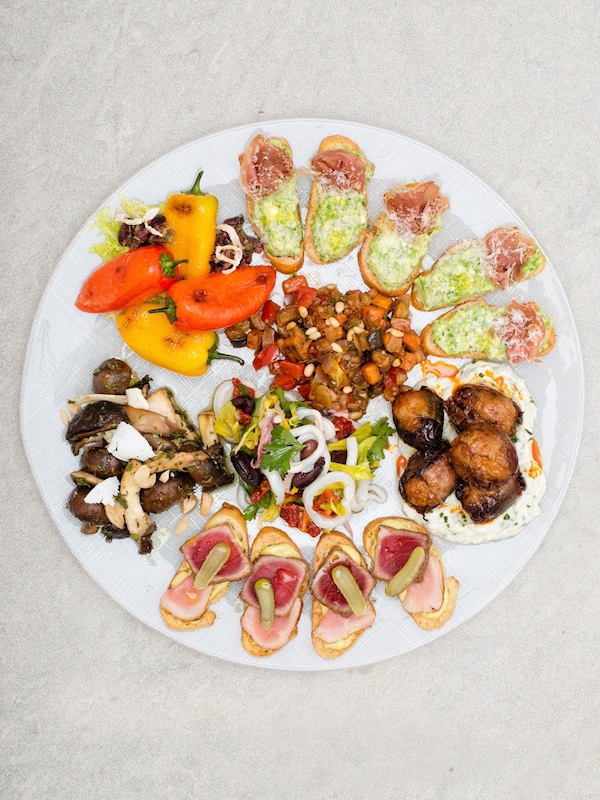 everyone
riveted to their plates. Recipes like a pasta e fagioli soup takes this time-worn warhorse and
gives it a whole new personality
with small, tubular ditalini pasta, cannellini beans
and finely
diced carrots, all suspended in a first-class broth.
Or a black truffle pizzette: so
crispy, chewy, so rich and intense you will wonder
how so much
flavor can be packed into so small a triangle.
Vegetable dishes like artichokes two ways (roasted and
deep-fried), will have you re-thinking your attitude towards healthful
edibles, and her pastas, like farrotto–a
risotto-like dish made with farro
and morels--will have you wondering how something so sumptuous can leave you
feeling so light. The same holds true for the side dishes: the peas with
parsley, pancetta,
pecorino, crispy polenta and sweet corn with spicy
sausage show real attention to detail and are more than worth the $10
price tag.
everyone
riveted to their plates. Recipes like a pasta e fagioli soup takes this time-worn warhorse and
gives it a whole new personality
with small, tubular ditalini pasta, cannellini beans
and finely
diced carrots, all suspended in a first-class broth.
Or a black truffle pizzette: so
crispy, chewy, so rich and intense you will wonder
how so much
flavor can be packed into so small a triangle.
Vegetable dishes like artichokes two ways (roasted and
deep-fried), will have you re-thinking your attitude towards healthful
edibles, and her pastas, like farrotto–a
risotto-like dish made with farro
and morels--will have you wondering how something so sumptuous can leave you
feeling so light. The same holds true for the side dishes: the peas with
parsley, pancetta,
pecorino, crispy polenta and sweet corn with spicy
sausage show real attention to detail and are more than worth the $10
price tag.For a pièce de resistance, you can hardly do better than Giada's whole roasted chicken for two with cacciatore sauce (below, right), consisting of a good bird, properly roasted, with the cacciatore portion served as a separate sauce, rather than the braising liquid in which the clucker was swimming as it cooked. Some might prefer the wetter version, but we found this one just perfect.
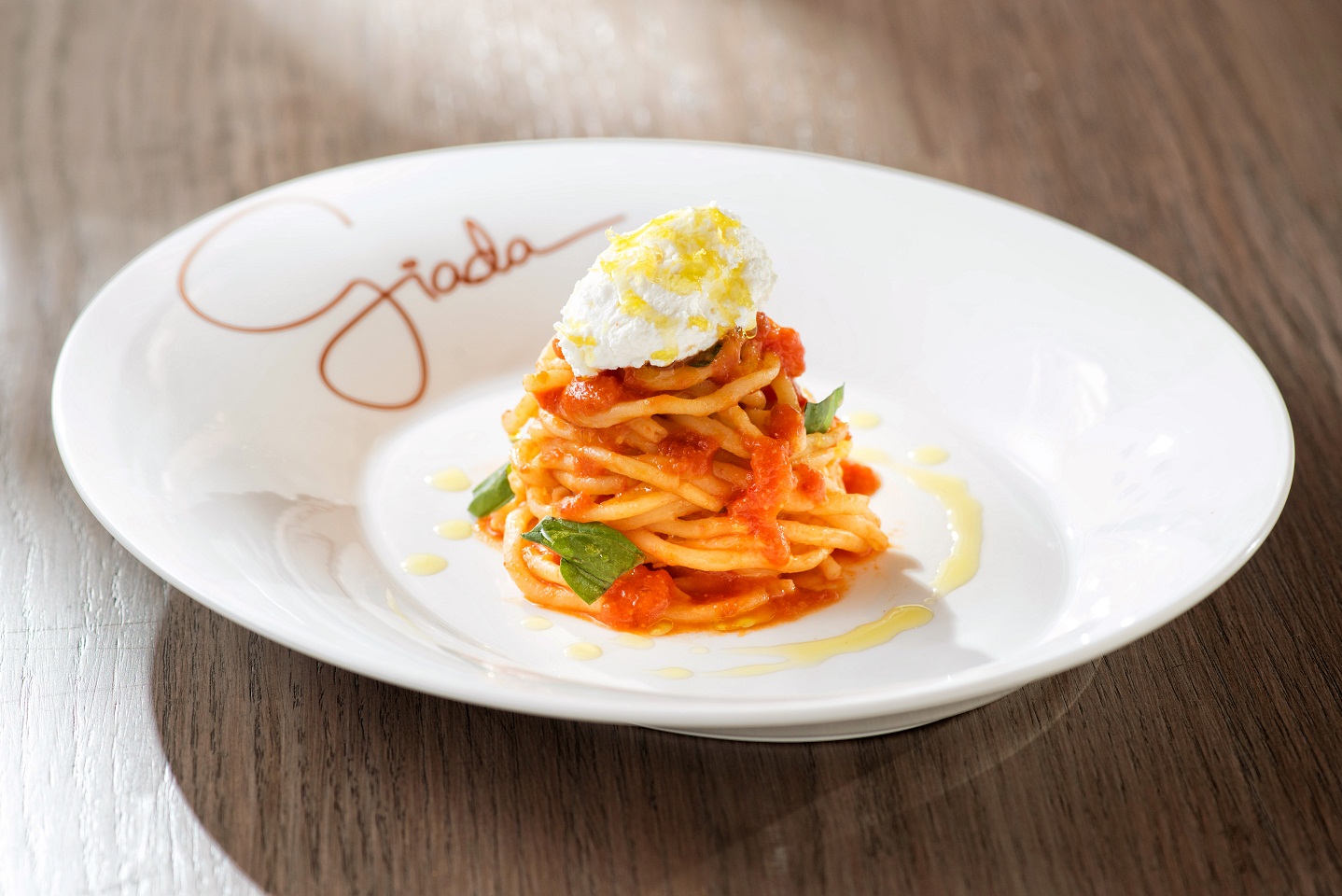 In
keeping with this "less liquid is more" philosophy,
Giada likewise believes
that Americans over-sauce their pasta (and she's
right),
In
keeping with this "less liquid is more" philosophy,
Giada likewise believes
that Americans over-sauce their pasta (and she's
right),so, she pretty much goes in the opposite direction with her rigatoni vegetarian Bolognese--something of an oxymoron for a sauce that's supposed to be meat-based--barely flecking her toothsome noodles with bits of vegetables, and making the dish no less delicious for it.
About the only offering we tried of ho-hum quality was a mascarpone and tarragon shrimp dish that looked and tasted like something straight out of a corporate kitchen--having none of the flavor, pop or dazzle of the rest of the menu. Speaking of dazzle, her signature spaghetti with lemon, shrimp and basil bathes good noodles in a creamy sauce that perfectly sets off the shrimp, while making you wonder why more pasta dishes don’t incorporate a citrusy tang like this one.
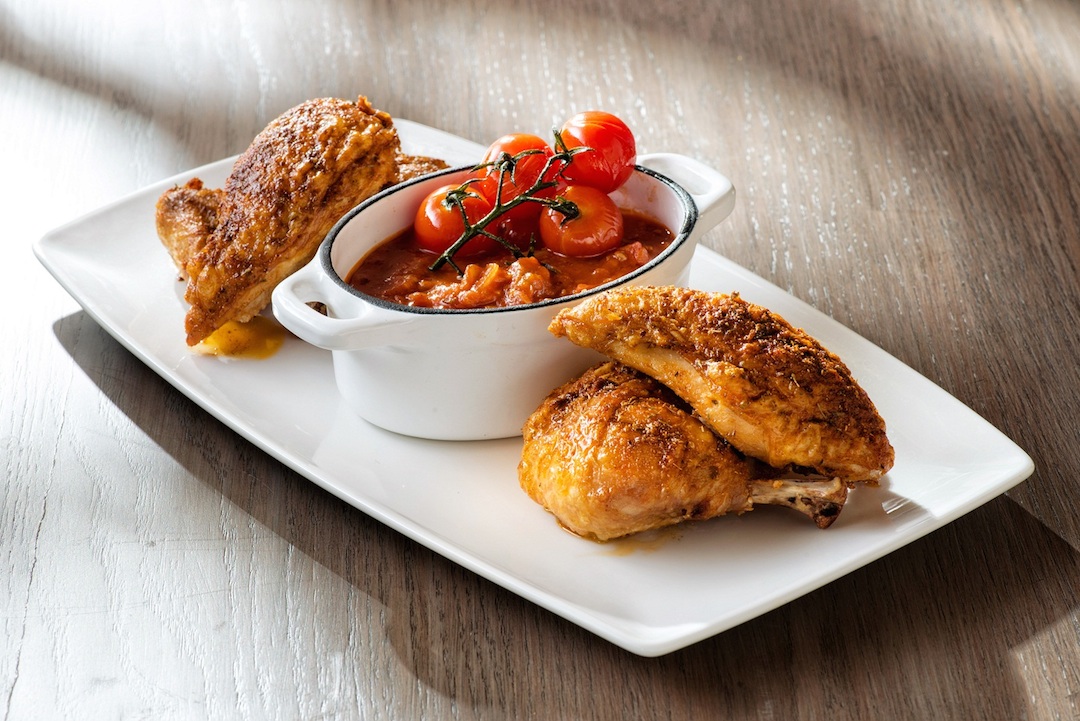
Much has been made in the local press about Giada's burning through chefs because she couldn’t find a good one. At present, she has settled on corporate toque Kurtess Mortensen to execute her recipes, and he and his crew are bringing their “A” game. Whether this quality control continues over time remains to be seen. Vegas celebrity chefs–at least the non-French ones--have a nasty habit of disappearing after all the opening hype dies down, except for photo ops once a year, but for the time being, you won’t find better Italian food anywhere in town.
Prices start at $8-$15 for appetizers, salads and soups, with pastas running $24-$30 and entrees going for $34-$78 (porterhouse for two). The wine list is typical for Vegas: unfocused, overpriced and all over the map. (Don’t blame the sommeliers, they’re just following orders.)
 GUY FIERI’S VEGAS
KITCHEN & BAR
GUY FIERI’S VEGAS
KITCHEN & BAR In The Quad
3535 Las Vegas Blvd. South
702-731-3311
thequadlv.com/restaurants/guy-fieri
At the other end of the socio-economic spectrum, the frosted-tipped one has ventured out on another gastronomic limb with another partner (this time Caesars Palace) and a management deal that (he promised!) would "bring the awesomeness." And here’s a surprise: it kinda does. In fact it's pretty darn good by upscale, bar food standards.
After the lambasting his Times Square restaurant took from the New York media last year, it appears Fieri (and his management team) have decided to step up to the plate and show the culinary world what they’re capable of. And what they’ve done is deliver good pub grub with libations to match to put right up there against every other gastropub in Las Vegas.
Before we get to the food itself, a word about the menu: much has been made of its contrived breathlessness over ”awesome pretzels,” "righteous" burgers and "head spinning" wings. Tastemakers, language police and fashion mavens love to point to such hyperbolic frippery as further proof of the gullibility of the unwashed masses, which, in turn, has hastened the demise of American literacy, humility in menu writing, and the fall of Western civilization in general.
Still, we didn't find the hyperbolic huckstering any worse than what you get at Applebee's, and unlike T.G.I. Fridays, or Chili's.

Before you get to the food, however, you will first notice two things about the restaurant: one, it's packed; and, two, it has an inside-outside vibe that will make you want to pass the afternoon tossing back cold ones from a good beer list, and engaging in some people watching. While you are watching the human parade going by, you will may find yourself coming under the spell of Fieri's faithful rendition of chicken street tacos--lip-smacking versions of Mexican street food as interpreted and upgraded by a professional chef. They tasted of grilled chicken, rather than white, shredded nothingness, and with a topping of house-pickled onions, were as fresh and balanced as one of these little pockets can be. Likewise, the Asian chicken wraps contain deeply flavored minced chicken along with moist, peppery Thai skewers and several sauces that made no apologies for being made by a bunch of white guys. The only clinker in our first lunch here was a 'Triple B' burger so smothered and infused with blue cheese that the meat could've been armadillo for all we could taste. As overwhelming as the construct of that cheese-fest was, one of its brethren–the bacon mac-n-cheese burger–was a thing of beauty. A good, hand-formed burger gets topped with applewood smoked bacon and a compressed mound of mac-n-cheese that could easily stand on its own as a great side dish. For the record, we’re no fans of mile-high, over-stacked, ground beef sandwiches, but this one–packed on a gorgeous brioche bun–is a vertical ode to excess.
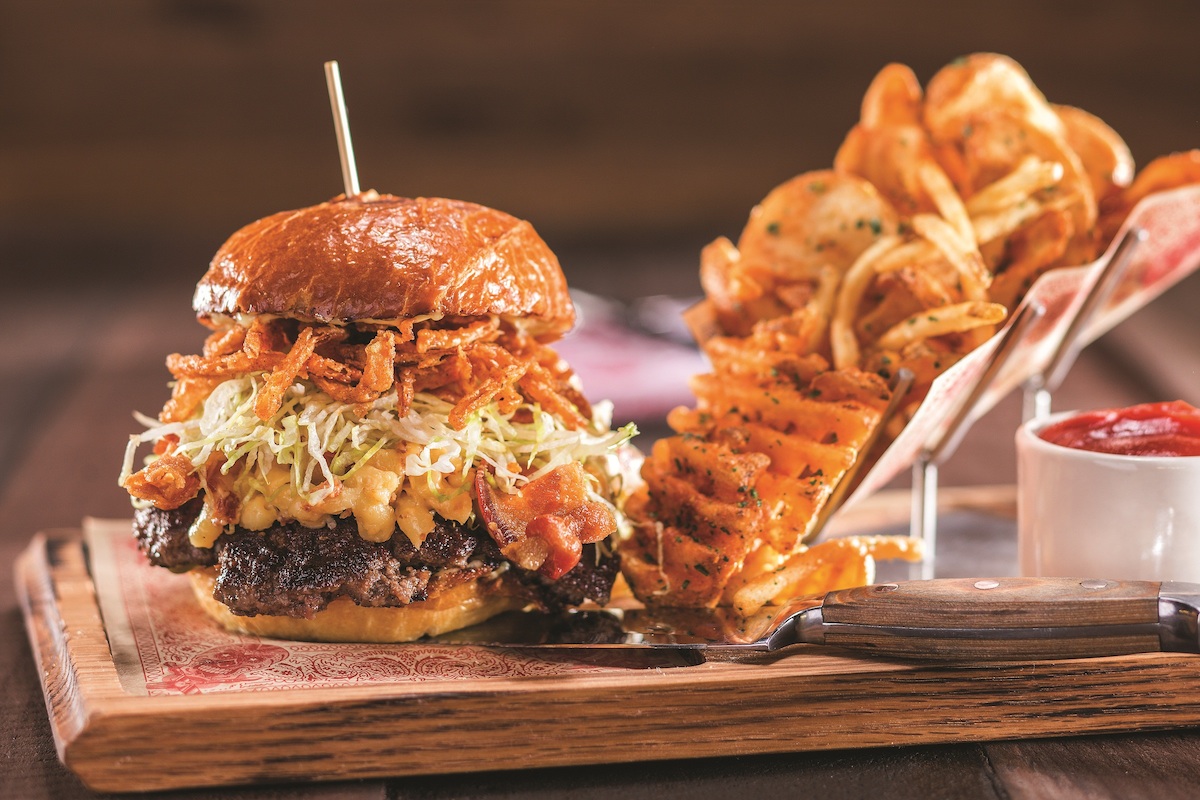 Speaking
of
respect, no self-respecting,
celebrity-chef-exploitation restaurant would ever think of not
bragging about its chicken wings, and the ones here actually taste like
Fieri learned a thing or two in cooking school at UNLV (or from delving into
diners and dives all over America for the past few years). Lovers of
the little flappers will love to hear that the four offerings here are stellar
variations on a theme, with the Fireball Whiskey Wings not being quite
as incendiary as the name would imply, but the brining and roasting
comes through with every bite The blue cheese sauce, called (ouch!)
blue-sabi on the menu, is a nod to Buffalo, NY. Equally good are
the "Parmagedden Wings," looking like little popsicles of chicken parm,
which come with a very decent, house-marinara sauce.
Speaking
of
respect, no self-respecting,
celebrity-chef-exploitation restaurant would ever think of not
bragging about its chicken wings, and the ones here actually taste like
Fieri learned a thing or two in cooking school at UNLV (or from delving into
diners and dives all over America for the past few years). Lovers of
the little flappers will love to hear that the four offerings here are stellar
variations on a theme, with the Fireball Whiskey Wings not being quite
as incendiary as the name would imply, but the brining and roasting
comes through with every bite The blue cheese sauce, called (ouch!)
blue-sabi on the menu, is a nod to Buffalo, NY. Equally good are
the "Parmagedden Wings," looking like little popsicles of chicken parm,
which come with a very decent, house-marinara sauce.The fressers in your crowd will no doubt swoon over the Big Dipper--a behemoth of shaved, smoked prime rib served with crispy onions on a huge garlic torpedo roll. It's about as subtle as a Game of Thrones plot point, but no less excellent for it. There's even a nod to healthier eating among all these heart-stoppers, with four large salads--the "Guy-Talian Deli" version full of plenty of cheesy, meaty and tangy, with decent (albeit domestic) prosciutto and provolone used to good effect.
Desserts are what you would expect: large and in charge. Fried ice cream the size of a softball or a slab of cheesecake the size of a dictionary comes to your table and seems perfect for the room, the clientele, and a palate by then overwhelmed by the take-no-prisoners spicing of the menu. None of these concoctions will win any culinary awards, but they echo the homey, rib-sticking sensibilities of Fieri's show. One would
have to be the ultimate humbug to not enjoy them on their own level.
And pretty much, that's what Fieri and his investors are asking of you: Take our restaurant on its own terms, as an homage to all the diners and dives that made the Big Guy famous, and we will show you a good time with some good food. That's all this restaurant is supposed to be and that's all it is. Maybe Pete Wells should give it a try.
The sandwiches are huge; the platters, salads and desserts are meant to be shared; and everything on the menu is priced between $13-$20. Open daily for brunch, lunch and dinner.
❖❖❖
By John Mariani
STRIP HOUSE
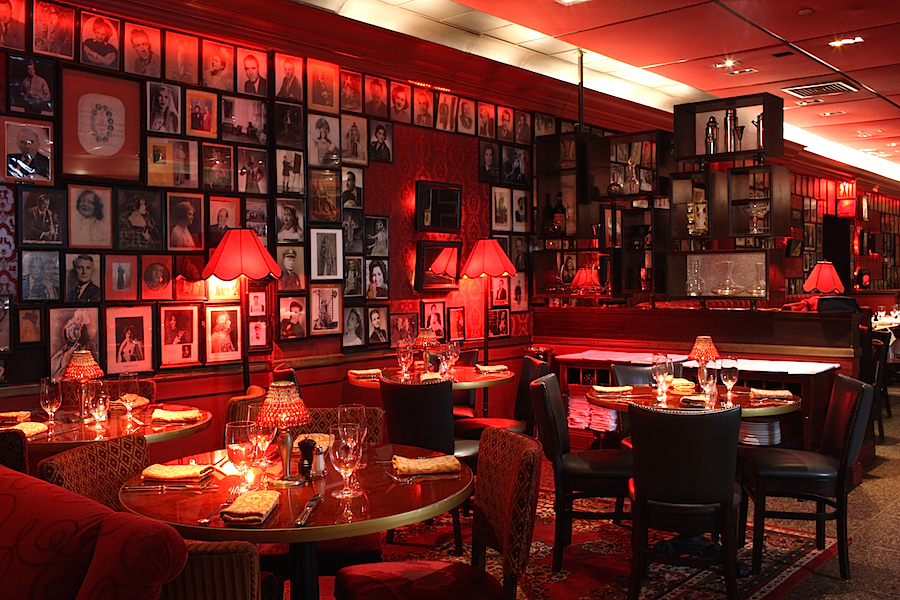
15 West 44th Street (off Fifth Avenue)
212-336-5454
striphouse.com
The look of American
steakhouses has changed measurably from the
time when they all looked exactly the
same--scuffed wood floors, scuffed yellow
walls, scuffed leather booths, and really
bad paintings.
These days, however, you
might find a new steakhouse done up like a New
York Yankees fantasy (NYY Steak) or like a
swanky boudoir (Prime in Las Vegas) or
Victorian western saloon (Del Frisco’s in
Dallas).
Certainly one of the most
distinctive designs is Strip House in New York,
with three locations (and one in Vegas), all
sharing the same raffish look of very crimson red
walls hung with original Studio Manasse prints of
1930s burlesque stars. (Women seem to have
looked a bit different in those days.)
This was the winkingly risqué
décor of the original Strip House in
Greenwich Village and is that of the new West 44th
Street location in a neighborhood crawling with
steakhouses--Palm, Spark’s, Wolfgang’s, Bobby
Van’s and more--all going all out to attract the
same free-spending macho clientele.
Strip House, on the other hand,
is clearly committed to making women feel just as
welcome as their male counterparts. Indeed, the
restaurant is run by a management and staff whose
corporate name, BR Guest Hospitality, rings very
true.
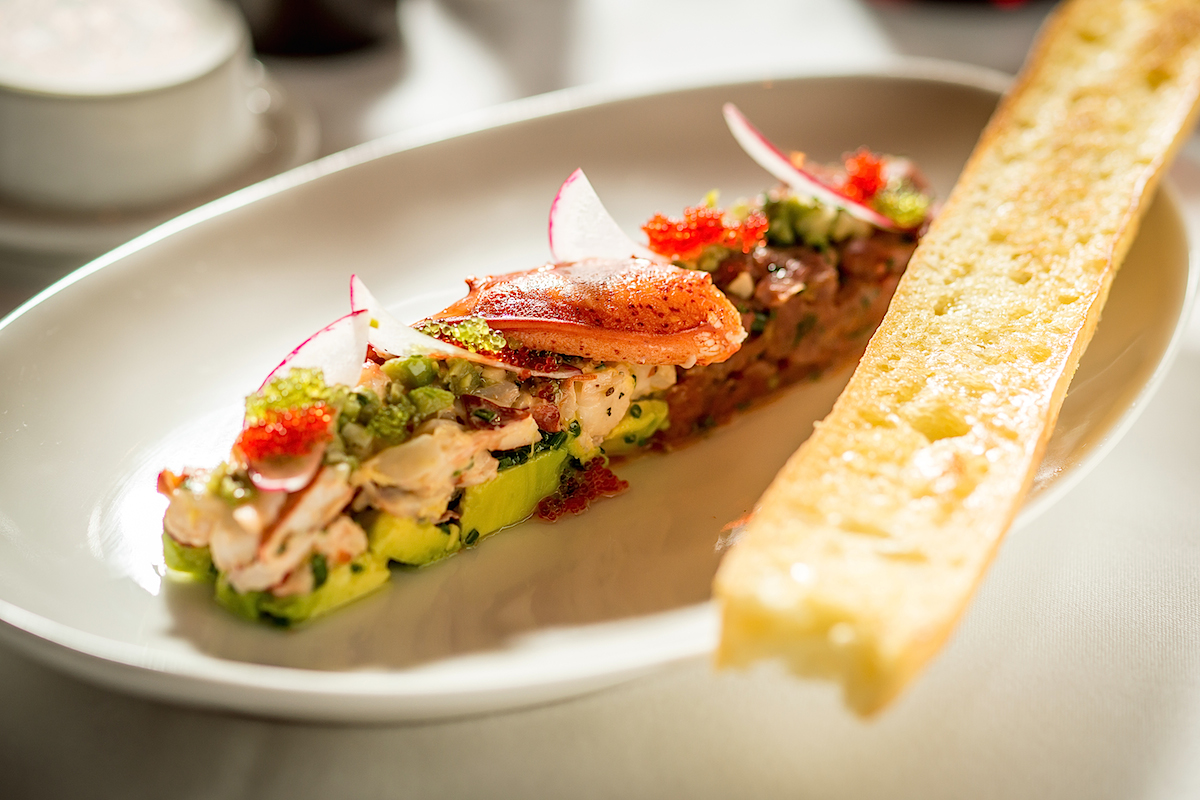 Executive
corporate chef Michael J. Vignola, whose c.v.
includes stints at Aquavit, The Modern and other
high-end restaurants, is in charge of making sure
there are no surprises for regulars who trek
between Strip Houses. So the menus don’t
differ much from one another, except for a few
specials, and they really don’t differ much from
the sacrosanct formula of steakhouses elsewhere in
the city; so it is in the quality of the
ingredients and their preparation that the
differences show, as well as in the reception at
the door, which is warmly cordial--not always the
case elsewhere.
Executive
corporate chef Michael J. Vignola, whose c.v.
includes stints at Aquavit, The Modern and other
high-end restaurants, is in charge of making sure
there are no surprises for regulars who trek
between Strip Houses. So the menus don’t
differ much from one another, except for a few
specials, and they really don’t differ much from
the sacrosanct formula of steakhouses elsewhere in
the city; so it is in the quality of the
ingredients and their preparation that the
differences show, as well as in the reception at
the door, which is warmly cordial--not always the
case elsewhere.
It’s a
big place--upstairs and down--but the kitchen
keeps pace. The wine list is geared to the kind of
food served at a steakhouse: lots of big reds and
white Burgundies. Mark-ups seem to run about
two-and-a-half times retail, but there are some
good buys on the “Sommelier’s Selections” list,
with Dominus 2007 going for $375, which is only
about $15 more than you’d pay in a store.
The food overall
is as good as the best steakhouses in NYC, and
better than many that cut corners. Oysters (six
for $19) were excellent; spicy tuna tartare ($19)
with chopped avocado, cucumber, radish sprouts and
a shot of wasabi (above) was full flavored and not
in the least watery; the roasted bacon ($18) was
as expected--irresistible as ever--and a lobster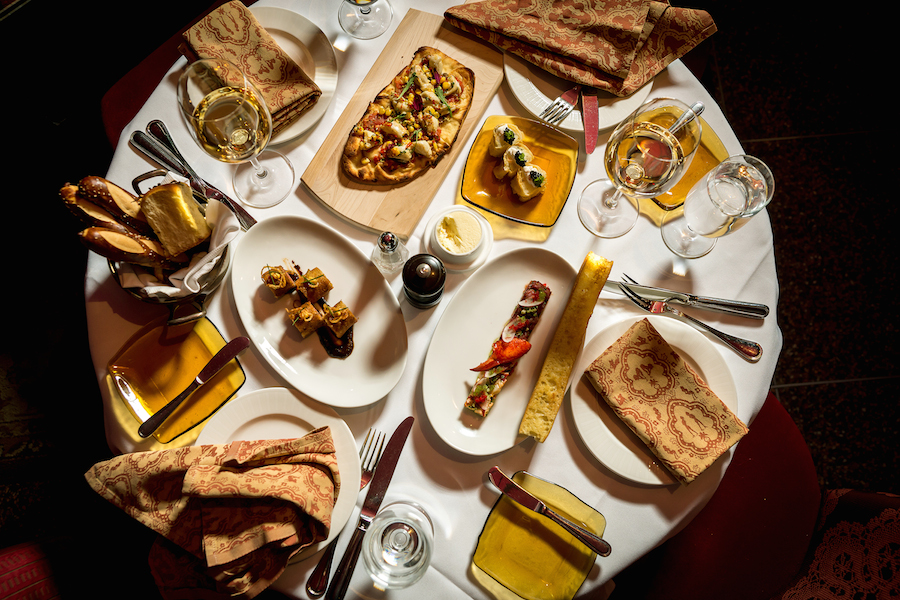 bisque
($14) had both lightness and richness on its side,
with fine lobster flavor and pearl couscous for
texture.
bisque
($14) had both lightness and richness on its side,
with fine lobster flavor and pearl couscous for
texture.
A special one
evening was a pâté, whose taste was
livery and whose flaccid crust was a far cry from
what you’d find in a good French bistro almost
anywhere. The one real disappointment of the
evening was a steamed three-pound lobster (market
price), though it wasn’t the crustacean’s fault:
asked if we wanted the meat to be taken out of the
shell, I assented and soon realized that was
a mistake only because after the deed was
done back in the kitchen, while the steaks were
being cut and plated, the lobster meat got
lukewarm and dried out by the time it was
served. Next time I’ll ask for the waiter to
crack the shell at the table then have at it with
my fingers.
Strip House’s
true claim to a significant distinction from its
creditable competitors is that the cooks pay a lot
of attention to getting a serious char on the
outside of the meat, no matter how rare, medium
or--God forbid!--well done you might order
it. Impeccably seasoned, the steak, whether
it’s a ribeye ($48-$55), a tomahawk (below),
New York strip ($49), a porterhouse ($55),
whatever--will arrive seared and almost crispy,
something I so often have to beg for in other
steakhouses and rarely get what I crave. Our
table of four sampled a number of cuts, and every
one had the right char and the right interior
temperature.
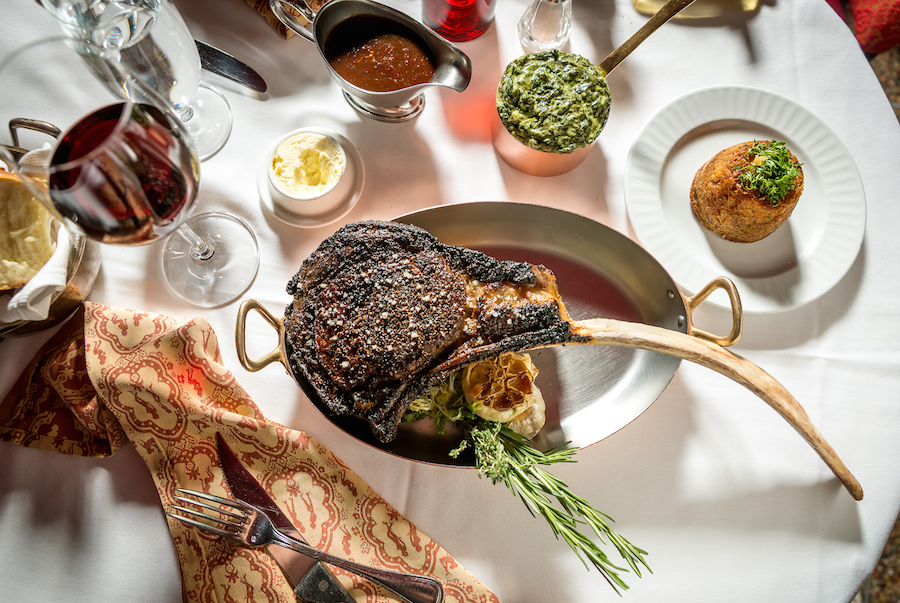 There
isn't much argument on this point, for this is the
only way a great piece of beef should be
rendered. So it is to Strip House’s credit that
they knock it out of the park every time.
There
isn't much argument on this point, for this is the
only way a great piece of beef should be
rendered. So it is to Strip House’s credit that
they knock it out of the park every time.
The chain prides
itself on its sides and they are very
good--asparagus, creamed spinach with black
truffles, buttered mashed potatoes and twice-baked
gratin potatoes ($12). The “whipped potato
puree” ($8) is not worth the effort; it's
soupy. But you’ve got to go with the goose
fat potatoes ($12), which are worth every guilty
bite. Their desserts have a lot of heft, not least
the signature chocolate cake ($16), though it’s
really only another mile high version of those
thousand-layer cakes steakhouses seem to mount
without much thought of density or
moistness. No matter how many people at your
table, you’ll take the cake slice home.
One
more thing about Strip House I applaud. On
the menu is written “As a courtesy please take
phone calls outside.” Not every guest is
going to pay attention--not to mention those
tables of women with their iPhones at the ready in
the big loud dining room--but it’s an attempt to
bring back a time when civilized behavior
precluded such things. People used to know
without being told.
❖❖❖
HILLROCK ESTATE WHISKEYS AND JACK DANIELS

By Mort Hochstein
It
was a perfect summer day, not a cloud in
sight.
A
gentle breeze sent waves rippling through the field
of barley. And if you listened closely, the rustling
sound could have been a musical riff. From the
deck at Hillrock Estate distillery (above), we had
a picture postcard view of greenery, whispering
battalions of grain and, on a rise overlooking this
bucolic scene, a restored 1806 mansion.
Craft distilleries, like
artisan beer breweries, are sprouting up in many
parts of the country. Hillrock Estate, about an
hour's ride north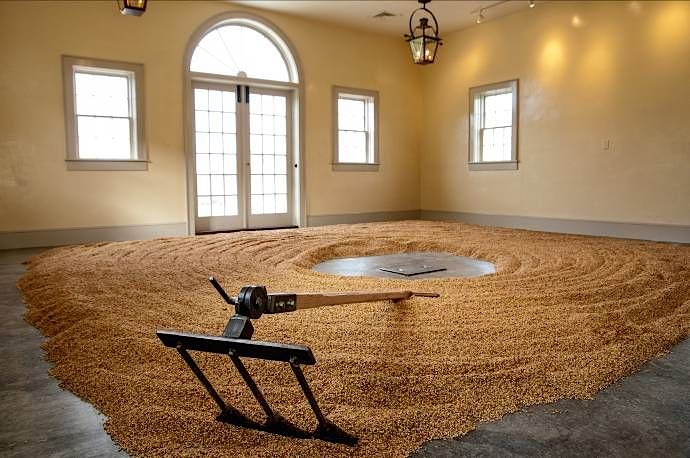 of NYC, is
a little under three years old and, even at this
early stage, is turning out fine bourbon, rye, and
single malt whiskey. It is easy to see why
entrepreneur Jeffrey Baker chose the lush farmland
of New York's Columbia County for his venture. This
gorgeous site, near the town of Ancram, is far off
the well-traveled roads that lead north to the
tourist attractions of the Berkshires and west to
Albany, the state's capital. This is getaway weekend
country for the Wall Street crowd and the horsey
set, though there are few signs of equine activity
in the manicured fields surrounding the distillery,
visitor center, malt house and granary.
of NYC, is
a little under three years old and, even at this
early stage, is turning out fine bourbon, rye, and
single malt whiskey. It is easy to see why
entrepreneur Jeffrey Baker chose the lush farmland
of New York's Columbia County for his venture. This
gorgeous site, near the town of Ancram, is far off
the well-traveled roads that lead north to the
tourist attractions of the Berkshires and west to
Albany, the state's capital. This is getaway weekend
country for the Wall Street crowd and the horsey
set, though there are few signs of equine activity
in the manicured fields surrounding the distillery,
visitor center, malt house and granary.
Baker proudly describes
his distillery as “field to glass,” meaning that
farming, malting and distilling are totally
integrated on site. He is particularly proud of the
malt house, which revives an ancient procedure
seldom seen in contemporary distilleries. Malted
grain is a vital element in beer and whiskey,
providing enzymes needed to convert the grain's
starches into sugars and to break down proteins that
yeast transforms into alcohol.
Malting
involves steeping grain in water for several days to
allow it to absorb moisture and start to sprout.
When the grain is nearly 50% liquid, it is
spread out on a malting floor (above), where
it is raked by hand and constantly turned around for
about five days until it is air dried. This
calls for considerable manual labor.
On my first trip to
Scotland many years ago (Ancram is named after a
town in Scotland) I saw malting floors at many
distilleries. They are a rarity now, having been
supplanted by more advanced forms of drying, usually
conducted at facilities designed for large-scale
malting. Baker's artisan approach called for the
first malting floor to be built in the United States
since Prohibition. It is then distilled in
copper stills (left).
 Hillrock uses the
solera process, traditionally employed to create
sherries, ports, brandy and some Scotch whiskeys.
The solera is a stack of casks where small amounts
of mature whiskey are drawn from the lowest barrel
and replaced by an equal measure of younger whiskeys
flowing in steps from the stack. There is never an
empty barrel and the average age and complexity
increases over time as the younger whiskey matures
on its downward journey.
Hillrock uses the
solera process, traditionally employed to create
sherries, ports, brandy and some Scotch whiskeys.
The solera is a stack of casks where small amounts
of mature whiskey are drawn from the lowest barrel
and replaced by an equal measure of younger whiskeys
flowing in steps from the stack. There is never an
empty barrel and the average age and complexity
increases over time as the younger whiskey matures
on its downward journey.
Hillrock’s Solera Aged Bourbon ($86),
which is finished for five weeks in 20-year-old
Oloroso Sherry casks, is the first Solera aged
whiskey to be made in the United States.
Dave Pickerell,
previously with Maker's Mark Distillery, is master
distiller for all Hillrock products. Though he
spends most of his time at Hillrock, he is also
master distiller for George Washington’s Distillery
at Mount Vernon and consults for other producers. In
addition to the Solera Aged
Bourbon, Pickerell’s current Hillrock portfolio
includes a Double Cask Rye ($90), Estate Single Malt
($100) and George Washington’s Rye Whiskey ($50).
Hillrock's line is technically available only in
NYC, but several Manhattan retailers carrying the
line can make ordering and shipping arrangements. 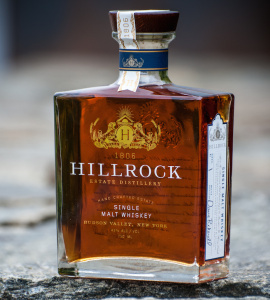
Pickerell has been in the business for
three decades and is a man of strong opinions, one
being that American whiskey is the world's best. "It
goes from moonshine all the way up to refined,
ultra-premium bourbons and ryes and everything in
between. Not only do we have the history and
tradition of big boys that have refined the
whiskey-making process for hundreds of years, but we
also have an incredibly large and vibrant craft
community that is taking all of this knowledge and
expanding it in new directions. I think we’re
moving out of `just give me vodka,’ and the cocktail
culture is a part of it. People want to be
stimulated, the want to taste all kinds of
interesting forms."
Change
comes rapidly these days, particularly among the
“big boys” Pickerell cites. Jack Daniel's, the
Tennessee whiskey that cannot legally be called
bourbon--and vice versa--because of its unique
mellowing procedures, lists nearly three dozen line
extensions, and continues to experiment, a recent
innovation being honey-flavored bourbon.
Jack Daniel's was first
to register during the early 1860s, when the federal
government began regulating and taxing whiskey, and
its plant in Lynchburg, Tennessee, is America’s
oldest registered distillery, listed on the National
Register of Historic Places (below).
Its popularity soared in the '80s and '90s
when Frank Sinatra embraced it. The singer
plugged Jack Daniel's unashamedly and rarely
appeared without a bottle of Old Number 7 ($22),
which he referred to simply as “Jack,” nearby.
 Capitalizing on the relationship,
the distillery created a special Frank Sinatra
bottling (below)
that jumped off the store shelves so fast that it
could not meet demand. Originally sold only at
the Jack Daniel's visitors center and at airports,
Sinatra Select ($175) is somewhat more available
now, though it's a bottle that store owners often
keep under the counter for favored customers.
Capitalizing on the relationship,
the distillery created a special Frank Sinatra
bottling (below)
that jumped off the store shelves so fast that it
could not meet demand. Originally sold only at
the Jack Daniel's visitors center and at airports,
Sinatra Select ($175) is somewhat more available
now, though it's a bottle that store owners often
keep under the counter for favored customers.
While
his competitors switched to less time-consuming
methods of making whiskey, Mr. Jack, as the
distiller was known, stuck with his
charcoal-mellowing process, mellowing the spirit
through ten feet of charcoal derived from hard sugar
maple. That made Jack Daniel's whiskey three times
as long to produce and about twice as expensive, but
it also gave it a smooth, refined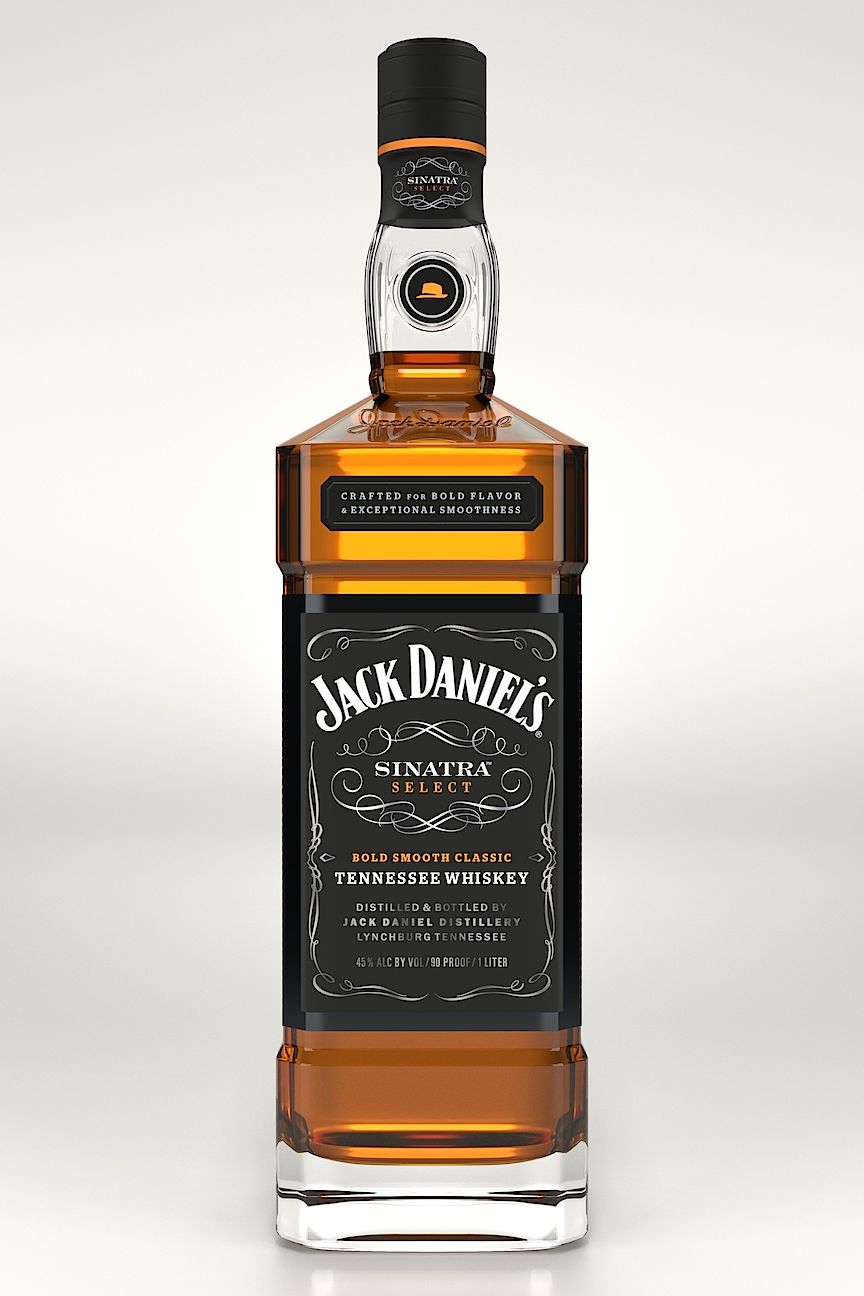 character.
Mellowing this way changed the product enough that
the government gave it a special designation as
“Tennessee Whiskey.”
character.
Mellowing this way changed the product enough that
the government gave it a special designation as
“Tennessee Whiskey.”
Display cases at the
Visitors Center in Lynchburg are lined with limited
run and anniversary bottlings, as well as
experiments with new flavors. Many have been
produced to meet the demand for something new and
different or something striking enough to draw
public attention, like Tennessee Honey ($22) or
Tennessee Fire ($22), tasting something like
cinnamon candy.
Travelers can tour the Jack
Daniel's plant by calling the visitors center at
931-759- 6357. Tourists are also welcome at
Hillrock, though there is no formal program, except
during an occasional open house. Call
518-329-1023. .
 WEE SOO YOO
WEE SOO YOO
Eleven servers and busboys filed a lawsuit against Ji Sung
Yoo, owner of
NYC's Kum
Gang San restaurant, alleging they were forced
to work 18-hour shifts with no overtime, attend Sunday
church service conducted at the restaurant, pick cabbage
at a NJ farm, and face "humiliation, termination, and
threats of blacklisting and deportation." Mr. Yoo was
also alleged to tell his employees to "drop on
their knees and beg for his forgiveness, or leave" if
they did not attend farm days. The workers say they had
to mow the lawn, do laundry, shovel snow at Ji Sung
Yoo's house, and help his son move.
SLIP SLIDIN' AWAY

A
highway in North Yorkshire, England, was blocked
in both directions when a truck accidentally
overturned and dumped its load of instant mashed
potato mix all over the pavement, causing unsafe driving
conditions when the instant potato mix started expanding
into mashed potatoes (right).
Police initially treated the potatoes with chemicals to
attempt to freeze them, which did not work. The fire
department was then called out to try to blast the
mashed potatoes off the road with high-powered hoses.
Any of John Mariani's
books below may be ordered from amazon.com.
 |
The Encyclopedia of American Food and Drink by John F. Mariani (Bloomsbury USA, $35) Modesty forbids me to praise my own new book, but let me proudly say that it is an extensive revision of the 4th edition that appeared more than a decade ago, before locavores, molecular cuisine, modernist cuisine, the Food Network and so much more, now included. Word origins have been completely updated, as have per capita consumption and production stats. Most important, for the first time since publication in the 1980s, the book includes more than 100 biographies of Americans who have changed the way we cook, eat and drink -- from Fannie Farmer and Julia Child to Robert Mondavi and Thomas Keller. "This book is amazing! It has entries for everything from `abalone' to `zwieback,' plus more than 500 recipes for classic American dishes and drinks."--Devra First, The Boston Globe. "Much needed in any kitchen library."--Bon Appetit. |
"Eating Italian will never be the same after reading John Mariani's entertaining and savory gastronomical history of the cuisine of Italy and how it won over appetites worldwide. . . . This book is such a tasteful narrative that it will literally make you hungry for Italian food and arouse your appetite for gastronomical history."--Don Oldenburg, USA Today. "Italian
restaurants--some good, some glitzy--far
outnumber their French rivals. Many of
these establishments are zestfully described
in How Italian Food Conquered the World, an
entertaining and fact-filled chronicle by
food-and-wine correspondent John F.
Mariani."--Aram Bakshian Jr., Wall Street
Journal.
"Equal parts
history, sociology, gastronomy, and just
plain fun, How Italian Food Conquered the
World tells the captivating and delicious
story of the (let's face it) everybody's
favorite cuisine with clarity, verve and
more than one surprise."--Colman Andrews,
editorial director of The Daily
Meal.com. "A fantastic and fascinating
read, covering everything from the influence
of Venice's spice trade to the impact of
Italian immigrants in America and the
evolution of alta cucina. This book will
serve as a terrific resource to anyone
interested in the real story of Italian
food."--Mary Ann Esposito, host of PBS-TV's
Ciao
Italia. "John Mariani has written the
definitive history of how Italians won their
way into our hearts, minds, and
stomachs. It's a story of pleasure over
pomp and taste over technique."--Danny Meyer,
owner of NYC restaurants Union Square
Cafe, The Modern, and Maialino.
|
 |
 |
 |
 |
 |
 |
 |
 |
 Everett Potter's Travel Report:
Everett Potter's Travel Report: 
 Eating Las Vegas
is the new on-line site for Virtual Gourmet
contributor John A. Curtas., who since 1995
has been commenting on the Las Vegas food
scene and reviewing restaurants for Nevada
Public Radio. He is also the
restaurant critic for KLAS TV, Channel 8 in
Las Vegas, and his past reviews can be
accessed at KNPR.org.
Click on the logo below to go directly to
his site.
Eating Las Vegas
is the new on-line site for Virtual Gourmet
contributor John A. Curtas., who since 1995
has been commenting on the Las Vegas food
scene and reviewing restaurants for Nevada
Public Radio. He is also the
restaurant critic for KLAS TV, Channel 8 in
Las Vegas, and his past reviews can be
accessed at KNPR.org.
Click on the logo below to go directly to
his site.

Tennis Resorts Online: A Critical Guide to the World's Best Tennis Resorts and Tennis Camps, published by ROGER COX, who has spent more than two decades writing about tennis travel, including a 17-year stretch for Tennis magazine. He has also written for Arthur Frommer's Budget Travel, New York Magazine, Travel & Leisure, Esquire, Money, USTA Magazine, Men's Journal, and The Robb Report. He has authored two books-The World's Best Tennis Vacations (Stephen Greene Press/Viking Penguin, 1990) and The Best Places to Stay in the Rockies (Houghton Mifflin, 1992 & 1994), and the Melbourne (Australia) chapter to the Wall Street Journal Business Guide to Cities of the Pacific Rim (Fodor's Travel Guides, 1991).


MARIANI'S VIRTUAL GOURMET
NEWSLETTER is published weekly. Editor/Publisher: John
Mariani.
Editor: Walter Bagley. Contributing Writers: Christopher Mariani,
Robert Mariani, John A.
Curtas, Edward Brivio, Mort Hochstein, Andrew Chalk,
and Brian Freedman. Contributing
Photographers: Galina Stepanoff-Dargery,
Bobby Pirillo. Technical Advisor: Gerry McLoughlin.
To un-subscribe from this newsletter,click here.
© copyright John Mariani 2014
